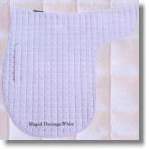
Shaped Dressage Saddle Pad
$25.00
| |
|
Saddle-Fitting 101
|
Ian Hastilow, the co-founder of Hastilow Competition Saddles of B&H Saddlery in the United Kingdom, and his brother, Andrew, have recently spent 10 days in the Maryland, Virginia, and Pennsylvania area offering clinics and saddling tips for local horse owners. During the sessions, he provides details on things to look for in the proper fit of the saddle for both the horse and the rider.
In checking the fit of the saddle, Hastilow runs his fingers and hands carefully down the back of the horse, along the back muscles on each side of the spine, working backwards from the withers. He notes any flinching, dipping of the back, or other signs of the horse suffering from back pain, all of which indicate the potential problem of an ill-fitting saddle. He then places the saddle on the back without a saddle pad or girth so he can better evaluate how the saddle fits on the back, checking for pressure points where the saddle rests unevenly. At times, he has the rider mount the horse, to further assess where the saddle may apply uneven pressure on the horse’s back.
Hastilow emphasizes that the key to the proper fit begins with the tree of the saddle. If it is too wide for the withers, then the saddle will tip forward. If it is too narrow for the withers, then it will tip backwards. He notes that one frequently sees soft tissue damage from the incorrect fit of the tree. Once the tree is the proper fit, then the gullet between the panels should be wide and even, with the panels placing even pressure on the each side of the spine. The pommel should clear the withers with ample amount of space and the cantle should rest evenly on the back.
One of the most common problems he encounters during these clinics is the lack of attention to the saddle once it has been purchased and used for a certain length of time. While it may have fit perfectly when it was bought, the rider often forgets to continue to check its fit. The flocking, the material inside the panels, has worn down, but the rider doesn’t notice this because the process has been too gradual. He pointed out that, ideally, a saddle should be checked and maybe reflocked from new after 6 to 8 weeks, and then once a year thereafter. For the saddles they make, Hastilow provides the first reflocking free of charge because he recognizes the importance of the proper fit and wants to encourage owners to follow through with the maintenance of one of their saddles.
Most often an incorrect fit can be fixed with reflocking. If the saddle rocks forward, the flocking can be added in the front part of panels, thereby raising the pommel up off the withers. Likewise, if the saddle tips backwards, flocking is inserted towards the back to lift the cantle. No matter where the attention needs to be given, Hastilow still ensures that the flocking with the entire panel has been redistributed and more added to ensure the proper fit. Once the saddle has been reflocked, he likes for the rider to sit again in the saddle on the horse to ensure that the work is complete and both rider and horse are comfortable and satisfied.
At the clinic that day, if Hastilow determines that the problem can be fixed with reflocking, he immediately disassembles the saddle and deftly adds and redistributes the white wool with expert feel and movement. His brother, Andrew, then skillfully sews the panel back to the seat, making sure the stitching is pulled tight for perfect alignment. They fix a number of saddles in this manner in just a few hours time.
Unfortunately, there are a few saddles presented that have been made with foam padding in the panels. While these saddles are lighter, they can not be reflocked. Even though he manufactures a few saddles with the foam panels, Hastilow prefers wool because it molds to the shape and holds that shape better and firmer, and can be readjusted very simply. The foam panels, which are more commonly found in saddles made in the United States, “collapse” more quickly and can not be restuffed. While you can try to add flocking, it will not hold. For those people he encounters who have this type of saddle, he recommends using riser pads to adjust the fit and provide more even pressure. Sometimes these solutions have to be creative, with multiple layers of different types of padding. This is not an ideal answer, however, and only benefits the horse for the short term. Though gel pads can also work, he points out that a rider must be careful because they can pull too tight across the withers and/or back, adding to the discomfort.
A saddle is one of the most important investments the rider will make for his or her horse – not only because of the price, but more importantly because of the fit and comfort of the horse. Hastilow emphasizes that one should maintain the saddle with care. Not only does this include having the flocking checked on a regular basis, but also oiling and cleaning the saddle itself. If made and maintained properly, this can be an investment that will last the lifetime of the horse and maybe even longer.
For a look at the Hastilow saddles, as well as the history of the company, go to www.hastilow.co.uk. They are planning more trips to the U.S., and specifically this region, for more saddle fitting clinics. MDhorse.com will notify you of those future dates and locations.
|
|
|
|
|
|
|



